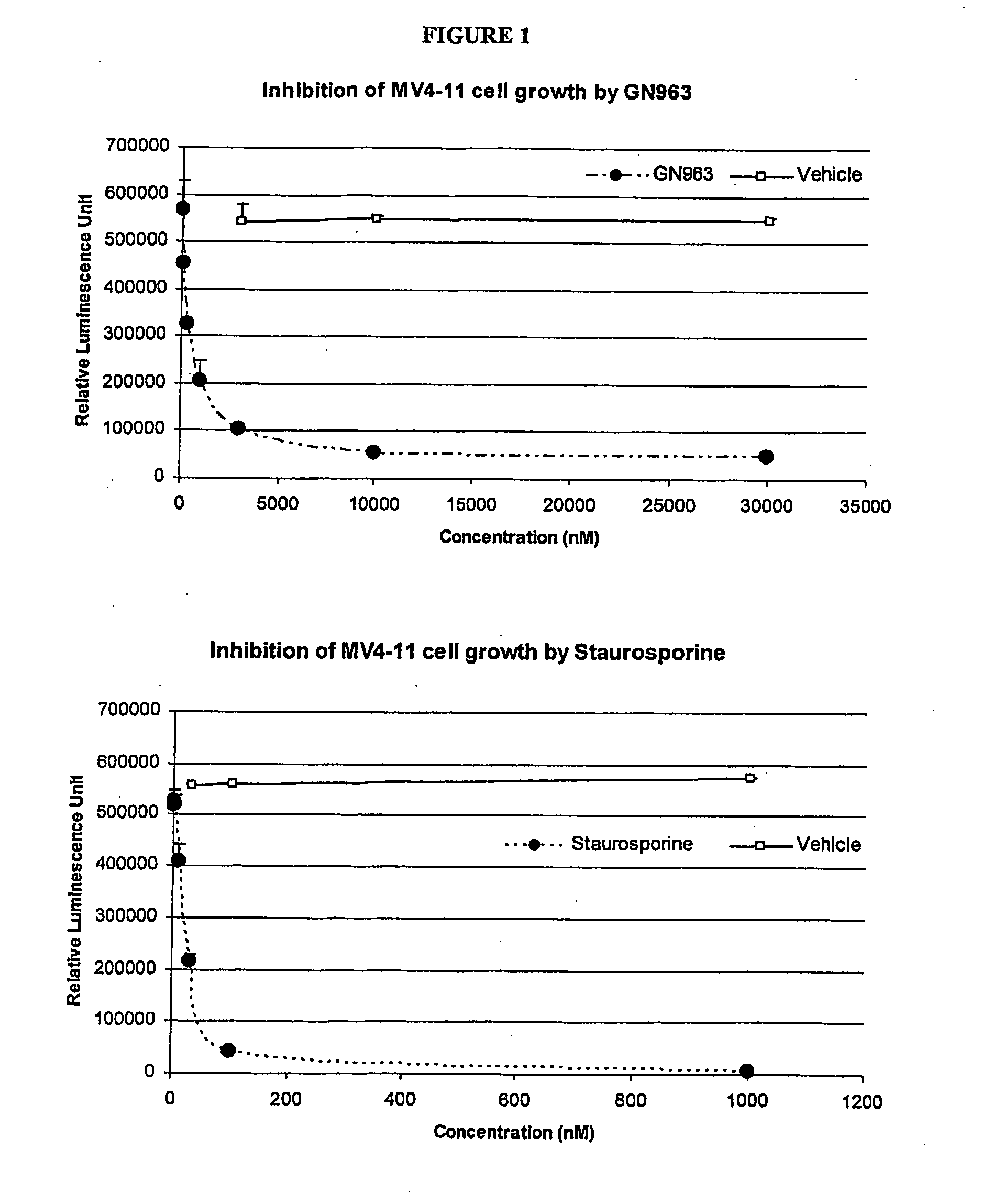Anti-vascular and anti-proliferation methods, therapies, and combinations employing specific tyrosine kinase inhibitors
a technology of tyrosine kinase and anti-proliferation, which is applied in the field of antivascular and antiproliferation methods, therapies, and combinations employing specific tyrosine kinase inhibitors, which can solve the problems of not being able to abrogate the mature vasculature, agents from these classes of compounds, and not being able to inhibit insulin action in most normal circumstances
- Summary
- Abstract
- Description
- Claims
- Application Information
AI Technical Summary
Benefits of technology
Problems solved by technology
Method used
Image
Examples
example 20
3-Cyclohexyloxy-6,7-dimethoxyquinoxaline 1-oxide
[0539] A mixture of 2-cyclohexyloxy-6,7-dimethoxyquinoxaline (110 mg, 0.38 mmole) and meta-chlorobenzoic peracid (70%, 113 mg, 0.46 mmole) in 10 mL of methylene chloride is stirred at room temperature for one day. The solution after filtration is concentrated and the residue is chromatographed on silica gel (20% ethyl acetate / hexane) to provide the desired product (m.p. 167-169° C.). [0540] trans-4-(6,7-Dimethoxy-4-oxy-quinoxalin-2-ylamino)-cyclohexanol (m.p. 220-222° C.) is prepared similarly. Anal. Calcd. for C16H21N3O4●0.2 H2O: C, 59.42; H, 6.69; N, 12.99; Found: C, 59.43; H, 6.64; N, 12.95.
example 21
Acetic acid trans-4-(6,7-dimethoxyquinoxalin-2-ylamino)-cyclohexyl ester
[0541] A mixture of trans-4-(6,7-dimethoxyquinoxalin-2-ylamino)-cyclohexanol (303 mg, 1 mmol), acetic anhydride (2 mL) and pyridine (2 mL) in 10 mL of dichloromethane is stirred at room temperature overnight. The mixture is quenched with water (5 mL) and extracted with dichloromethane (2×30 mL). After drying over magnesium sulfate and filtration, the solution is concentrated on a rotovap. The residue is chromatographed on silica gel (ethyl acetate) to provide the desired acetate as a light yellow solid (m.p. 176-177° C.). Anal. Calcd. for C18H23N3O4: C, 62.59; H, 6.71; N, 12.17; Found: C, 62.89; H, 6.67; N, 11.95.
example 22
(2exo,5exo)-5-(6,7-Dimethoxyquinoxaline-2-ylamino)-bicyclo[2.2.1]heptan-2-ol
[0542] A mixture of (2exo,5exo)-5-aminobicyclo[2.2.1]heptan-2-acetate (127 mg, 0.75 mmol) and 2-chloro-6,7-dimethoxyquinoxaline (224 mg, 1 mmol ) is heated to 180° C. for six hours. After which time, the mixture is cooled to room temperature, dissolved in methylene chloride and purified via flash column. The recovered product (20 mg, 7.5% yield) is dissolved in methanol (2 mL), and a fresh solution of 1 N sodium methoxide (0.063 mL, 0.063 mmol) is added. The reaction mixture is refluxed for ninety minutes. The crude mixture is purified by preparative thin layer chromatography to provide the product as a yellow solid with a m.p. of 97-100° C. C17H21N3O3 (m / z): 315.
[0543] The following compounds are prepared similarly beginning with the appropriate starting material [0544] (2endo,5exo)-5-(6,7-Dimethoxyquinoline-2-ylamino)-bicyclo[2.2.1]heptan-2-ol, as a yellow solid. C17H21N3O3 (m / z): 315. (2exo,6exo)-6-(6,7...
PUM
| Property | Measurement | Unit |
|---|---|---|
| median survival time | aaaaa | aaaaa |
| time | aaaaa | aaaaa |
| temperature | aaaaa | aaaaa |
Abstract
Description
Claims
Application Information
 Login to View More
Login to View More - R&D
- Intellectual Property
- Life Sciences
- Materials
- Tech Scout
- Unparalleled Data Quality
- Higher Quality Content
- 60% Fewer Hallucinations
Browse by: Latest US Patents, China's latest patents, Technical Efficacy Thesaurus, Application Domain, Technology Topic, Popular Technical Reports.
© 2025 PatSnap. All rights reserved.Legal|Privacy policy|Modern Slavery Act Transparency Statement|Sitemap|About US| Contact US: help@patsnap.com



